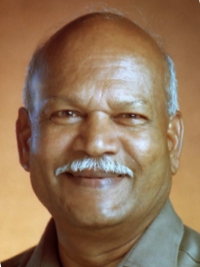Introduction to A Power Point Presentation in Europe: May 2008
In the recent years study of Jainism has become one of the most exciting and rapidly expanding fields in Asian studies. The study of Jaina Art, Architecture, Literature and Philosophy is picking up in several countries. Scholars have come to know that Jainism has its own canons and temple tradition reflecting the Jaina way life.
In this context, an earnest attempt is made here to briefly introduce an ancient site of historical significance.
Śravaṇabeḷagoḷa ('Jaina monk's white-lake'), the Pompeii of Jain history and the Vatican city of Jaina community, famed and haloed for a prolonged period of over two millennia, has preserved virtually intact a vibrant and vigorous religious tradition of peace and tranquillity.
Śravaṇabeḷagoḷa, tiny town of temples nestled between two ancient Hills of greater significance, is a rare enchanting place from where the pilgrim returns with a sense of fulfilment and spiritual bliss. People blessed with eye sight should see Śravaṇabeḷagoḷa to discover Jaina ethos.
Seeing the panoramic view of the two majestic Hills, magnificent temples, monolithic mānastambhas (characteristic Jaina pillar of eminence), hundreds of inscriptions and the awesome 58.8 foot high Bāhubali colossus of this millennia-old holy centre, one will recall the words of Mark Twain -(Śravaṇabeḷagoḷa) is older than history, older than tradition, older even than legend and looks twice as old as all of them put together.
The smaller Hill or Candragiri in common parlance, has its other names recorded in inscriptions - Tīrthagiri, Ṛṣigiri and Kaḷvappu (Sk. Kaṭavapra). This hill was basically a sepulchre Hill. Ever since Bhadrabāhu breathed his last on the apex of this Hill, observing the vow of sallekhana became an act of sanctity. Bare-chested men and white-clad women, both with folded hands as a gesture of devotion, climbing the steps is a common sight. Similarly ever since apostle Bhadrabāhu with his cortege of disciples including Candragupta Maurya migrated here in the wake of twelve years famine in the third century BCE, the Deccan became the realm of larger Indian culture and politics. Karnataka became the melting pot of regional cultures and Śravaṇabeḷagoḷa bloomed as a cultural corridor of the country and a custodian of ancient tradition which is still alive here.
Earliest epigraphical records echo the spiritual and intellectual articulation of those who visited the place for over a thousand and five hundred years. Śravaṇabeḷagoḷa is credited of having the highest number of inscriptions in one place in the country and that too all lithic records ranging from 600 CE to 1820 CE. The entire volume number two (2) of Epigraphia Carnatica is devoted to the inscriptions of Śravaṇabeḷagoḷa.
The monolithic colossus of Bāhubali, a sermon in stone and an extraordinary glimpse to behold on earth, has received an unprecedented amount of attention. Contrarily the inscriptions and the architecture have only figured sporadically in journals and researches. These inscriptions, about 575 in number are unique especially as seen from the point of view of history, culture and architecture.
Candragiri (named after Candragupta, the Mauryan emperor), the abode of sacrosanct shrines, is a silent witness to the historical vicissitudes spanning several centuries.
Wonderstruck by the intricacy of the temple architecture, we feel satisfied at having seen a slice of the elegance of the stone work and the skill that has gone into its making. Basked under the umbrella of royal patronage, these twelve temples dotting the summit of Candragiri are symbolic expressions of Jaina cultural heritage. A fascinating mixture of numerous traditions, philosophies and cultures, pulsing with life and intensity, are couched here. There are many Jinālayas on the two Hills and in the town proper. Every shrine, small or big, tells a story of its own.
The most celebrated among the temples on Candragiri is the Cāmuṇḍarāya Basadi. Built in the Drāviḍa style, the temple glitters like one more jewel in the crown of Cāmuṇḍarāya's innumerable achievements The Candragupta Basadi and the Pārsvanātha Basadi are equally important, for their architectural details.
In the town proper the huge Baṇḍāri Basadi, Akkana Basadi and the Maṭhada Basadi are splendid. The wall-paintings, inside Maṭhada Basadi, of late Vijayanagara period, depicting Jaina legendary themes are noteworthy. These paintings depict the life of Jina Pārśva and the story of Nāgakumāra. On the outskirts of the town is the Jinanāthapura Basadi which is unique for its architectural elegance and sculptural grandeur.
The history of bigger Hill called Vindhyagiri starts from 981 CE, the year of the consecration of the none other Statue of Bāhubali, which looks like suspended between earth and sky. The popular legend of Bāhubali can be summed up in few sentences as follows:
Bharata Cakravarti, the first Universal emperor after whom the country is known as Bhārata, was the eldest son of Ṛṣabha, the first of 24 Tīrthaṅtkaras. Coveting full power to become dictator, Bharata fought his younger brother Bāhubali. In the fight that ensued, Bāhubali emerged victorious. Both the brothers were charged with aḥaṅkāra, 'egoism', which emanated anger. Pride and piety cannot ride together. A flattered ego dramatically impaired Bharata's judgement, and an injured ego provoked Bāhubali to emerge in acts of retaliation. But when once the brothers realised the glory of the soul and cultivated positive thinking, they unburdened themselves parting with ego. They overpowered the frailties of the body and mind, and realised the power of the ātma, soul. Both could bury the hatchet at the end.
Yes, nobody travels on the road to success without a puncture or two!
Let us recollect the glorious moments of Bāhubali emerging from a solid block of rock. A thousand years ago many proficient sculptors climbed steep rocks burning under the scorching sun. Commissioned by the illustrious Cāmuṇḍarāya, minister and army chief of the Gaṅga king, who had an ambition clubbed with imagination, a group of expert artists worked on the Hill with their little iron tools. Days turned into weeks and months into years. The dedicated and skilled sculptor's skin turned into sunburnt leather. But inspired by the melody of chanting of sacred stanzas by monks, the dexterous artisans kept cutting and carving the in situ rock.
And one day, as the iron tools stopped playing music on the huge rock and layers of dust dissolved into crisp air, the beauty personified Bāhubali, the biggest free standing image in the world, emerged on the summit of the Hill as if the fully chiselled colossus had udbhava sprung from the earth. It was in the year 981, a thousand and twenty seven years ago.
With eyes open, dextral hair trimmed to its natural curves, a half-smile on the lovely lips, broad shoulders, mādhavi creepers entwining feet and arms, and snakes slithering near feet, Bāhubali alias Gommaṭa standing naked to suggest that he possessed nothing, stands immortalised in rock, stored for posterity. The matchless statue, with unbound compassion as his clothing and the open sky as his shelter, radiates peace and tranquillity. His heart beats for the entire mankind. Every look leaves exhilarating experiences of observing ascetic beauty.
Religion can rarely remain barren and empty without ritualistic spices. The mood and orientation of the votaries blossom in rituals.
The ritual of Mahā-mastaka-abhiṣeka, 'great head anointing', ceremony of Bāhubali statue usually takes place once in twelve years. A taste of Jaina history, culture and ritual unfolds with the most amazing spectacle of the ablution. While water, milk, curds, rice powder, sandal paste, flowers, sugarcane juice, mango juice etc., are poured over the statue from head downwards in reverence, its grandeur increases manifold. The vibrant and energetic ceremony heralding the arrival of creative spirit and reminding the transcendent dimension of life is a unique event. The summit of the Hill serves as the hypaethral temple for Bāhubali.
Bāhubali does not figure in the list of Triṣaṣṭi śalākā puruṣas, 'the 63 Great-Men' prescribed in Jaina tradition. In other words, he is neither a Tīrthaṅkara, nor a Cakravarti, or a Baladeva, or a Nārāyaṇa (Vāsudeva), or a Prati-Nārāyaṇa (Prati-Vāsudeva). He is a Kevalin, 'omniscient', and siddha, 'a liberated soul'. Because of his formidable austerity and renouncing the legitimate kingship in his very moment of triumph over his brother, Bāhubali has become so popular that he enjoys the Glory of a Tīrthaṅkara.
Now let us watch the history and architectural Glory of the ancient place through Audio Visual Presentation.
[I dedicate this brief introductory article to Prof. Dr. Adelheid Mette].
 Prof. Dr. Nagarajaiah Hampana
Prof. Dr. Nagarajaiah Hampana
